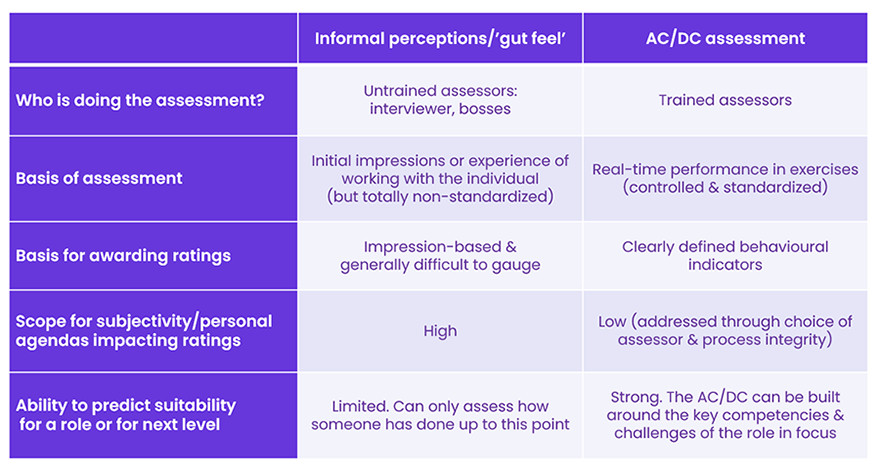
An Assessment Centre or Development Centre is any combination of objective selection techniques used to understand the skill or competency profile of a participant. An Assessment/Development Centre employs multiple assessment methods and exercises to evaluate participants across a range of competencies. The process is used to make a variety of employment decisions (e.g., employee selection, career development, promotion).
Exercises in Assessment or Development Centres are designed to simulate the actual challenges found on the job (such as handling a customer, managing a subordinate, interpreting business data, presenting and defending a business case, planning and prioritizing project deliverables etc.). Some of the commonly used assessment tools include the following:
These terms are often used interchangeably, even though it can be argued that there are clear differences between the two. Typically, the process is the same but the purpose to which the assessment results are put is quite different. Assessment Centres are primarily used to measure external candidates’ suitability for a job/role in terms of pre-defined competencies. The outcome is a hire/don’t hire decision. A Development Centre typically assesses existing employees with the purpose of identifying skill gaps in relation to current or future roles. It is the basis on which an individual development plan is created. From an assessor’s point of view there is little difference. The assessor will focus on accurate assessment of the participant’s performance on the exercise. The purpose to which this assessment will be put is a secondary factor.
Organizations need to make decisions about employees. These include:
There are obviously benefits to getting these decisions right. There are costs to getting these decisions wrong. Both the benefits and costs increase with the criticality of the role. In many cases these decisions are taken on a relatively informal basis such as the candidate’s CV and interview responses or the employee’s past performance and subjective perceptions of his/her ability to handle a higher-level role. An Assessment/Development Centre adds a formal evaluation to the decision-making process.
Consider the differences between the two types of data used to consider role suitability:

Unsurprisingly, the research suggests that the AC/DC approach has much higher predictive validity (i.e. it leads to the correct decision more of the time) and adding it to the decision-making process provides much richer data, allowing more informed and accurate decisions.
Traditionally, assessment centres have been conducted in batches or groups. You invite all participants to a common location and take them through a series of assessment exercises using a pre-planned schedule. Trained assessors observe them while they complete these exercises and use these observations to create a competency profile for each participant.
Click here to see a typical schedule template for a physical assessment centre.
Increasingly, organizations are looking to deliver talent management processes virtually. Assessment and development centres are no exception. The assessment framework for a virtual assessment centre remains broadly the same as a physical AC. However, the process of delivery changes significantly. In a virtual AC, the participant accesses and completes all the exercises remotely on a digital platform. The assessors also manage the entire assessment and report creation process virtually.
In many cases, the assessment centre can be organized in a hybrid delivery model. In such cases, participants can be asked to first complete some of the exercises virtually and then come to a common physical location to complete the other exercises F2F.
Using physical assessment centres have many issues & challenges. Some of these are:
Physical assessment centers require participants and assessors to be present at a common location. The organizing team (typically from HR function) has to put in a lot of coordination effort to block suitable venue and organize travel for all stakeholders. The cost of travel and venue adds significantly to the cost of the Program
Physical assessment centers typically are organized in batches of 8 to 16 participants. This works well in case of assessments conducted in development context. However, in case the assessment is to be conducted for hiring or promotion purposes, the requirement is often to conduct the process separately for each participant.
Given the higher logistics effort and cost, it is often difficult to scale up physical assessment centre processes. The physical delivery option becomes challenging in case the Organization is looking to cover a large number of people through the process.
These challenges are leading to most organizations exploring virtual delivery models.
In the next blogs in the series, we will go deeper into other concepts related to design of assessment centres (e.g. competency framework, typical AC Exercises & Competency-Instrument Mapping) as well as how to use observations from assessment centres to create participant profiles.
Schedule a call to activate your account — and start using the tools right away.
© 2025 Elemetrik. All rights reserved.